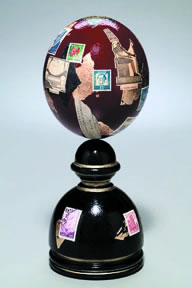
Great Houses of Chicago 1871-1921
Susan Benjamin and Stuart Cohen
Foreword by Franz Schulze and Arthur H. Miller
9 x 12 inches, 334 pages, ISBN: 978-0-926464-39-8 •
$75.00 Acanthus Press
SAH and Chicago Chapter members Susan Benjamin and Stuart Cohen have produced the most comprehensive overview on Chicago’s mansions, castles and residential fortresses.
This outstanding volume balances diverse sources and matches the pantheon of architects with those early patrons - the pioneers, nouveau riche and old eastern money. Nearly 350 sepia toned photographs, drawings, and floor plans are breathtaking in scope and detail. The visual content effectively evokes the muffled footsteps of parlor maids and rebukes by gruff railroad barons.
Rare figures of inhabitants intervene only occasionally; a child on a tricycle, Mr. Eliphalet Blatchford in his library but mostly the human presence consists of portraits above highly embellished fireplaces. The majority of these pictures were taken as silent documents of wealth and expressions of erudition but they evoke a surprisingly shaky, unconfident sense of style.
Even so, readers will derive a clear sense of each family’s private aesthetic and public facade. Interior design and decorative arts are as compelling as the structures. Paintings, sculpture, textiles, carvings, animal skins, all manner of souvenirs from grand tours and chotzkes galore - are piled in impeccable abandon.
It's tempting to search for the very few objects that found their way to the Art Insitute's collection.
The Editorial content is superb in providing the ontology of Chicago’s residential style, social context, family history and the sources of wealth.
Great Chicago Houses is also peppered with aridly amusing anecdotes. It makes a surprisingly entertaining read.
I was especially touched by the 1903 Julius Rosenwald House by Nimmons & Fellows and the authors' treatment. The book’s testimony to one of the greatest of Chicago’s early entrepreneurs and philanthropists is gracious and the house itself is uncomplicated but beautifully designed.
The strange sadness that pervade the book - especially for a lifelong Chicagoan - is linked with the number of demolished structures. I've been thinking about this a lot lately. These captains of industry built these palazzo's on the prairie to last. The quality of workmanship and materials was meant to echo the european structures that they saw on their trips. It was one of their frequent and futile, strikes at immortality. I wonder if they imagined that their children would inhabit the houses after them, shuddering from the capitalistic ghosts of their patriarchs or if they thought there would be tremendous competition to acquire their peculiar ornate newel posts (done - but in salvage yards).
For the great majority - their ghosts left with a wrecking ball within fifty or sixty years! They built with a sense of permanence and luxury that would institutionalize their memories but technology, location and that wierd, short cycle - 30 years after construction - when vernacular architecure becomes distasteful - killed a lot of them.
Chicago's growth continues -- inevitable, consistent and totally unrepentant in ravaging the past.
One note for the 2nd edition: while some photo dates are available in the Illustration Credits, label dates or indication of the probable range when the pictures were taken (circa) or even “date unknown” would provide an even richer context. Knowing if the varnish on the spindles is dry or decades old would add polish to this significant volume.

 Images courtesy of Acanthus Press.
Images courtesy of Acanthus Press.Again, With Mrs. H.
Mrs. Huxtable's brilliant contruction in the Wall Street Journal includes an archicentric use of the word "terroir" and this ruthlessly correct phrase:As usual, I agree with every character she writes even though a good friend has admonished
not to idolize, deify or carve a pedastal - I can't help myself. Why don't we hear her.
It reminds me of what Frank Lloyd Wright said about Adlai Stevenson: "He didn't win because Americans don't like a thinking man in the White House."
The Financial Times Version of the Island of Doctor Moreau
Try to get a cab or a 2 bedroom vintage rental.


No comments:
Post a Comment